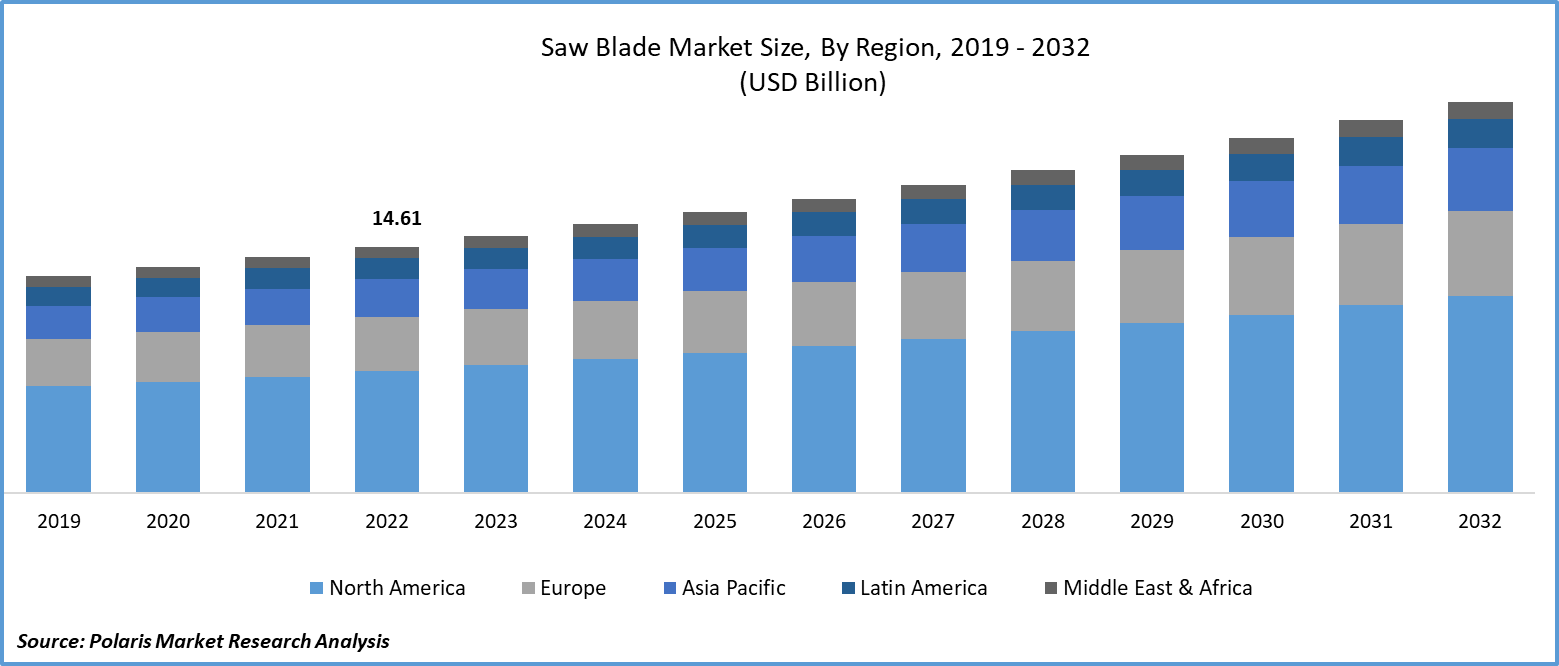
Saw Blade Market Share, Size, Trends, Industry Analysis Report, By Product Type (Circular Saw Blades, Band Saw Blades, Chain Saw Blades, Hand Saw Blades, and Others); By Material; By Application; By Region; Segment Forecast, 2024 – 2032
- Published Date:Jan-2024
- Pages: 116
- Format: PDF
- Report ID: PM3970
- Base Year: 2023
- Historical Data: 2019-2022
Report Outlook
The global saw blade market size and share is projected to witness robust growth. It was valued at USD 15.26 billion in 2023 and is projected to grow to USD 23.17 billion By 2032 exhibiting a CAGR of 4.70% in the forecast period 2024 - 2032.
The significant use of saw blades specially designed to be used with several types of saws, such as band saws, circular saws, jig saws, reciprocating saws, and many others, along with the emerging trend of DIY and the rising proliferation of tailor-made saw blades in order to meet specific cutting needs, are the primary factors boosting the global market growth. In addition, rising introduction to new and more advanced saw blade designs like thin-kerf blades and laser-cut features and penetration for the integration of smart technologies such as IoT and sensors in table saw blades for providing access to real-time monitoring and better performance are further anticipated to generate huge growth potential for the market.
The interchangeable toothed cutting components found in a variety of hand instruments, as well as movable and stationary power tools, are known as saw blades. Their serrated patterns and typically single-piece construction positioned them apart from other mechanical cutting forms. They are used to cut wood, brick, bone, metal, etc. It is made up of several teeth that work together to cut. You must decide if you plan to use the blade for crosscutting or ripping, as the number of teeth changes based on a variety of criteria, including application.
Also, a positive market outlook is being provided by the expanding supply of premium saw blades that can cut with clean, smooth edges, eliminating the need for extra finishing work. Aside from this, the saw blade market demand is expanding because of the growing emphasis on preserving saw blade functionality to improve safety by lowering the possibility of kickbacks and accidents. It is also expanding because of the increasing integration of automation and the Internet of Things (IoT) in saw blade manufacture and customization.

To Understand More About this Research: Request a Free Sample Report
- For instance, in December 2022, Bahco, a global leader in the bandsaw industry having over 140 years of experience in manufacturing saw blades and cutting tools, announced the expansion of its bandsaw blade portfolio with its new trimetal bandsaw blade. The newly launched blade offers users an easier, faster, and long-lasting blade life and can be used to cut a wide array of materials.
Moreover, there is a rising prevalence of the incorporation of several types of advanced coatings, such as titanium nitride, carbide, and diamond coatings, that are significantly applied to saw blades for reducing friction, increasing heat resistance, and improving overall cutting efficiency while also extending the lifespan of the blade, are likely to be the factors pushing the global saw blade market growth forward.
The outbreak of the COVID-19 pandemic has significantly impacted the growth of the saw blade market. The rapid spread of the deadly coronavirus across the globe led to the closure or slowdown of many manufacturing facilities and construction projects due to lockdowns and supply chain disruptions, which resulted in decreased demand for saw blades worldwide. Many manufacturers also faced several challenges in obtaining raw materials and components needed for producing saw blades, which led to increased prices and reduced production.
The saw blade market study is a compilation of first-hand data, quantitative and qualitative assessments by industry experts, and inputs from the most relevant stakeholders in the value chain. It uses a number of analytical tools to study and assess the data of key industry players and their saw blade market share. Analytical tools used to prepare the report include SWOT analysis, Porter’s Five Forces analysis, feasibility study, and investment return analysis, amongst others.

Industry Dynamics
Growth Drivers
- Growing use of saw blades to modify the look of infrastructural projects
There has been an exponential rise in the development of various industries, including construction, woodworking, and manufacturing, leading to greater demand for and sales of saw blades worldwide. Besides this, with the drastic increase in urbanization and the growing number of smart cities worldwide, resulting in a higher need for new commercial spaces, residential complexes, and public facilities, the market for saw blades is likely to gain significant traction over the coming years.
The rising global interest in do-it-yourself projects and home improvement activities across both developed and developing economies, which is likely to empower individuals to take better control of their living spaces and allow them to express their creativity more effectively, is likely to foster market growth at a rapid pace.
Report Segmentation
The market is primarily segmented based on product type, material, application, and region.
|
By Product Type |
By Material |
By Application |
By Region |
|
|
|
|
To Understand the Scope of this Report: Speak to Analyst
By Product Type Analysis
- Circular saw blades segment accounted for the largest market share in 2022
The circular saw blades segment accounted for the largest share, mainly accelerated to extensive product use in the construction industry to perform various construction-related projects and in the woodworking industry for cutting wood and wood-based materials. Apart from this, ongoing maintenance and repair of infrastructure, including roads, bridges, and buildings, among others, that require cutting and shaping various materials, are anticipated to foster global market growth.
The band saw blades segment is projected to exhibit the fastest growth rate over the next coming years on account of growing innovations and advancements in band saw blade technology, such as the development of advanced materials, tooth geometrics and coatings, precision, and blade longevity.
By Materials Analysis
- Carbon steel segment expected to hold a substantial market share
The carbon steel segment is expected to hold a significant market share in terms of revenue throughout the study period. This is mainly due to the fact that carbon steel-based blades can cut a wide range of materials such as wood, plastic, non-ferrous metals, and some ferrous metals. Carbon steel saw blades can also handle diverse materials, making them suitable for a variety of applications. With the growing concern related to the environment and sustainability across the globe, the adoption of carbon steel saw blades has increased significantly. Carbon steel is a more environmentally friendly material compared to alternatives like carbide, which requires more energy-intensive manufacturing processes.
By Application Analysis
- Metal cutting segment is expected to witness the highest growth
The metal-cutting segment is expected to experience the highest growth rate during the projected period. This is primarily due to the surging demand for metal-cutting blades in various industries such as automotive, construction, aerospace, and manufacturing. Additionally, the emergence of industrial applications that require high-precision and clean cuts for their metal components has also contributed to this growth.
On the other hand, the wood-cutting segment led the industry market with a considerable revenue share in 2022. This can be attributed to the widespread use of saw blades in the wood industry and the prevalence of wooden furniture and several construction essentials. The growing advancements in saw blades have also allowed for more efficient cutting of various wood types.

Regional Insights
- North America region dominated the global market in 2022
The North America region dominated the global market. The regional market growth can be mainly attributed to the emergence of a do-it-yourself culture and various home renovation projects, along with the region’s rising commitment towards sustainable practices, which led to increased sales of eco-friendly and energy-efficient saw blades.
- For instance, as per the Joint Center for Housing Centres of Harvard University, the total spending on home improvement projects increased from USD 328 billion in 2019 to approx. USD 472 billion in 2022 and the number is estimated to reach USD 485 billion in 2023.
Asia Pacific will grow at a rapid pace, owing to the region’s rapid industrialization and urbanization and exponential growth in the construction and manufacturing sectors in developing countries. Also, the presence of vast manufacturing industries from various sectors ranging from electronics to furniture is resulting in increased need and demand for a wide array of cutting tools.

Key Market Players & Competitive Insights
The saw blade market is highly competitive with the presence of various regional or global market players all over the world. Top players operating in the market are continuously increasing their focus on several business development strategies including collaboration, partnerships, acquisitions, and new product launches, to cater to a wider customer base and expand their geographical presence worldwide.
Some of the major players operating in the global market include:
- AKE Knebel GmbH & Co. KG
- AMADA Holdings Co.
- Bosun
- Dimar Tooling
- Freud America Inc.
- Illinois Tool Works Inc.
- Ingersoll Rand Inc.
- Kinkelder B.V.
- Ledermann GmbH & Co. KG
- Leuco Tool Corporation
- OSTAR Tools
- Pilana Knives A.S.
- Simonds International LLC
- Stanley Black & Decker Inc.
- The M K Morse Company
Recent Developments
- In August 2022, LENOX, introduced WAVE EDGE, Reciprocating Saw Blade Technology made in the USA with global materials. The company also introduced reciprocating saw blades & line-ups of sub-brands for wood, plastic, metal, & demolition applications.
- In July 2021, CMT, announced the launch of its new ITK Xtreme Chrome Saw Blade series. The newly developed series of blades is mainly designed to fit the needs of all types of users from professional furniture & cabinet shop to DIY & contractors.
Saw Blade Market Report Scope
|
Report Attributes |
Details |
|
Market size value in 2024 |
USD 15.95 billion |
|
Revenue Forecast in 2032 |
USD 23.17 billion |
|
CAGR |
4.70% from 2024 – 2032 |
|
Base year |
2023 |
|
Historical data |
2019 – 2022 |
|
Forecast period |
2024 – 2032 |
|
Quantitative units |
Revenue in USD billion and CAGR from 2024 to 2032 |
|
Segments Covered |
By Product Type, By Material, By Application, By Region |
|
Regional scope |
North America, Europe, Asia Pacific, Latin America; Middle East & Africa |
|
Customization |
Report customization as per your requirements with respect to countries, region and segmentation. |
Seeking a more personalized report that meets your specific business needs? At Polaris Market Research, we’ll customize the research report for you. Our custom research will comprehensively cover business data and information you need to make strategic decisions and stay ahead of the curve.
Explore the landscape of the saw blade market in 2024 through detailed market share, size, and revenue growth rate statistics meticulously organized by Polaris Market Research Industry Reports. This expansive analysis goes beyond the present, offering a forward-looking market forecast till 2032, coupled with a perceptive historical overview. Immerse yourself in the depth of this industry analysis by acquiring a complimentary PDF download of the sample report.
